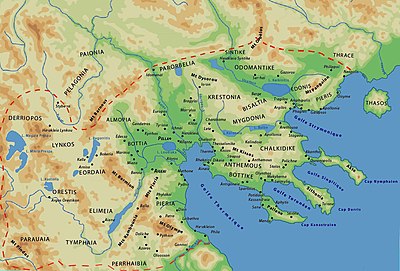Tymphaia
Tymphaia ( Greek Τυμφαία ), also called Stymphaia ( Στυμφαία ), in ancient times referred to the landscape of Greece that is bordered by the upper reaches of the Aliakmonas River in the north and east and the Pindus Mountains in the west.
The inhabitants of Tymphaia were Epiroten , but they mingled with the Macedonians from Elimiotis and Orestis , who settled on the other side of the Aliakmonas . In the middle of the 4th century BC The country was conquered by Philip II and integrated into Macedonia , since then it has often been assigned to the Upper Macedonian landscapes . In 335 BC Alexander the Great traversed this landscape on his twelve-day march from Pelion in Dassaretia to Thebes . The assimilation of the Tymphaeans into Macedonian society seems to have taken place extremely quickly. In the army of Alexander the great they formed their own battalion of the Pezhetairoi , whose leader Polyperchon could rise to the temporary ruler of Macedonia.
King Alexander V had to be in 294 BC Cede Tymphaia as well as Parauaia for the help of the Epirot king Pyrrhus to these. To what extent these areas fell back to Macedonia after his death is a matter of dispute, but they probably remained in the Epirot League until the Roman conquest.
literature
- Fritz Geyer: Macedonia up to Philip II's accession to the throne. In: Historische Zeitschrift , Vol. 30 (1930), pp. 1–148.
- John Van Antwerp Fine: The Problem of Macedonian Holdings in Epirus and Thessaly in 221 BC In: Transactions and Proceedings of the American Philological Association , Vol. 63 (1932), pp. 126-155.
